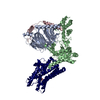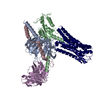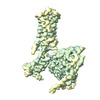[English] 日本語
 Yorodumi
Yorodumi- EMDB-41776: CryoEM structure of D2 dopamine receptor in complex with GoA KE m... -
+ Open data
Open data
- Basic information
Basic information
| Entry |  | |||||||||
|---|---|---|---|---|---|---|---|---|---|---|
| Title | CryoEM structure of D2 dopamine receptor in complex with GoA KE mutant and dopamine | |||||||||
 Map data Map data | ||||||||||
 Sample Sample |
| |||||||||
 Keywords Keywords | GPCR / Dopamine / DRD2 / Dominant Negative / MEMBRANE PROTEIN | |||||||||
| Function / homology |  Function and homology information Function and homology informationregulation of locomotion involved in locomotory behavior / negative regulation of dopamine receptor signaling pathway / positive regulation of dopamine uptake involved in synaptic transmission / negative regulation of circadian sleep/wake cycle, sleep / acid secretion / positive regulation of glial cell-derived neurotrophic factor production / dopamine neurotransmitter receptor activity, coupled via Gi/Go / auditory behavior / nervous system process involved in regulation of systemic arterial blood pressure / regulation of synapse structural plasticity ...regulation of locomotion involved in locomotory behavior / negative regulation of dopamine receptor signaling pathway / positive regulation of dopamine uptake involved in synaptic transmission / negative regulation of circadian sleep/wake cycle, sleep / acid secretion / positive regulation of glial cell-derived neurotrophic factor production / dopamine neurotransmitter receptor activity, coupled via Gi/Go / auditory behavior / nervous system process involved in regulation of systemic arterial blood pressure / regulation of synapse structural plasticity / response to histamine / positive regulation of renal sodium excretion / neuron-neuron synaptic transmission / adenohypophysis development / cerebral cortex GABAergic interneuron migration / regulation of potassium ion transport / hyaloid vascular plexus regression / negative regulation of neuron migration / Dopamine receptors / adenylate cyclase-inhibiting dopamine receptor signaling pathway / negative regulation of cellular response to hypoxia / orbitofrontal cortex development / response to inactivity / regulation of dopamine uptake involved in synaptic transmission / branching morphogenesis of a nerve / negative regulation of voltage-gated calcium channel activity / dopamine binding / negative regulation of dopamine secretion / positive regulation of growth hormone secretion / heterotrimeric G-protein binding / behavioral response to ethanol / drinking behavior / peristalsis / G protein-coupled receptor complex / phospholipase C-activating dopamine receptor signaling pathway / dopaminergic synapse / grooming behavior / positive regulation of urine volume / positive regulation of G protein-coupled receptor signaling pathway / striatum development / negative regulation of adenylate cyclase activity / negative regulation of synaptic transmission, glutamatergic / positive regulation of multicellular organism growth / G protein-coupled receptor internalization / non-motile cilium / vesicle docking involved in exocytosis / response to morphine / adult walking behavior / response to iron ion / ciliary membrane / regulation of synaptic transmission, GABAergic / G protein-coupled dopamine receptor signaling pathway / regulation of heart contraction / arachidonate secretion / temperature homeostasis / pigmentation / dopamine uptake involved in synaptic transmission / postsynaptic modulation of chemical synaptic transmission / dopamine metabolic process / regulation of dopamine secretion / positive regulation of neuroblast proliferation / heterocyclic compound binding / negative regulation of cytosolic calcium ion concentration / positive regulation of cytokinesis / associative learning / positive regulation of receptor internalization / behavioral response to cocaine / endocytic vesicle / negative regulation of phosphatidylinositol 3-kinase/protein kinase B signal transduction / mu-type opioid receptor binding / lateral plasma membrane / corticotropin-releasing hormone receptor 1 binding / G-protein alpha-subunit binding / neuroblast proliferation / response to light stimulus / sperm flagellum / response to axon injury / potassium channel regulator activity / GABA-ergic synapse / negative regulation of protein secretion / negative regulation of insulin secretion / long-term memory / G protein-coupled serotonin receptor binding / prepulse inhibition / adenylate cyclase-activating adrenergic receptor signaling pathway / muscle contraction / regulation of sodium ion transport / axon terminus / release of sequestered calcium ion into cytosol / synapse assembly / response to amphetamine / presynaptic modulation of chemical synaptic transmission / negative regulation of blood pressure / negative regulation of innate immune response / phosphatidylinositol 3-kinase/protein kinase B signal transduction / regulation of heart rate / axonogenesis / acrosomal vesicle / excitatory postsynaptic potential / negative regulation of protein phosphorylation Similarity search - Function | |||||||||
| Biological species |  Homo sapiens (human) Homo sapiens (human) | |||||||||
| Method | single particle reconstruction / cryo EM / Resolution: 3.28 Å | |||||||||
 Authors Authors | Krumm BE / Kapolka NJ / Fay JF / Roth BL | |||||||||
| Funding support |  United States, 1 items United States, 1 items
| |||||||||
 Citation Citation |  Journal: Nat Commun / Year: 2024 Journal: Nat Commun / Year: 2024Title: A neurodevelopmental disorder mutation locks G proteins in the transitory pre-activated state. Authors: Kevin M Knight / Brian E Krumm / Nicholas J Kapolka / W Grant Ludlam / Meng Cui / Sepehr Mani / Iya Prytkova / Elizabeth G Obarow / Tyler J Lefevre / Wenyuan Wei / Ning Ma / Xi-Ping Huang / ...Authors: Kevin M Knight / Brian E Krumm / Nicholas J Kapolka / W Grant Ludlam / Meng Cui / Sepehr Mani / Iya Prytkova / Elizabeth G Obarow / Tyler J Lefevre / Wenyuan Wei / Ning Ma / Xi-Ping Huang / Jonathan F Fay / Nagarajan Vaidehi / Alan V Smrcka / Paul A Slesinger / Diomedes E Logothetis / Kirill A Martemyanov / Bryan L Roth / Henrik G Dohlman /  Abstract: Many neurotransmitter receptors activate G proteins through exchange of GDP for GTP. The intermediate nucleotide-free state has eluded characterization, due largely to its inherent instability. Here ...Many neurotransmitter receptors activate G proteins through exchange of GDP for GTP. The intermediate nucleotide-free state has eluded characterization, due largely to its inherent instability. Here we characterize a G protein variant associated with a rare neurological disorder in humans. Gα has a charge reversal that clashes with the phosphate groups of GDP and GTP. As anticipated, the purified protein binds poorly to guanine nucleotides yet retains wild-type affinity for G protein βγ subunits. In cells with physiological concentrations of nucleotide, Gα forms a stable complex with receptors and Gβγ, impeding effector activation. Further, we demonstrate that the mutant can be easily purified in complex with dopamine-bound D2 receptors, and use cryo-electron microscopy to determine the structure, including both domains of Gα, without nucleotide or stabilizing nanobodies. These findings reveal the molecular basis for the first committed step of G protein activation, establish a mechanistic basis for a neurological disorder, provide a simplified strategy to determine receptor-G protein structures, and a method to detect high affinity agonist binding in cells. | |||||||||
| History |
|
- Structure visualization
Structure visualization
| Supplemental images |
|---|
- Downloads & links
Downloads & links
-EMDB archive
| Map data |  emd_41776.map.gz emd_41776.map.gz | 86.1 MB |  EMDB map data format EMDB map data format | |
|---|---|---|---|---|
| Header (meta data) |  emd-41776-v30.xml emd-41776-v30.xml emd-41776.xml emd-41776.xml | 19.4 KB 19.4 KB | Display Display |  EMDB header EMDB header |
| Images |  emd_41776.png emd_41776.png | 69.4 KB | ||
| Filedesc metadata |  emd-41776.cif.gz emd-41776.cif.gz | 6.5 KB | ||
| Others |  emd_41776_half_map_1.map.gz emd_41776_half_map_1.map.gz emd_41776_half_map_2.map.gz emd_41776_half_map_2.map.gz | 159.6 MB 159.6 MB | ||
| Archive directory |  http://ftp.pdbj.org/pub/emdb/structures/EMD-41776 http://ftp.pdbj.org/pub/emdb/structures/EMD-41776 ftp://ftp.pdbj.org/pub/emdb/structures/EMD-41776 ftp://ftp.pdbj.org/pub/emdb/structures/EMD-41776 | HTTPS FTP |
-Related structure data
| Related structure data |  8u02MC  8tzqC C: citing same article ( M: atomic model generated by this map |
|---|---|
| Similar structure data | Similarity search - Function & homology  F&H Search F&H Search |
- Links
Links
| EMDB pages |  EMDB (EBI/PDBe) / EMDB (EBI/PDBe) /  EMDataResource EMDataResource |
|---|---|
| Related items in Molecule of the Month |
- Map
Map
| File |  Download / File: emd_41776.map.gz / Format: CCP4 / Size: 172.1 MB / Type: IMAGE STORED AS FLOATING POINT NUMBER (4 BYTES) Download / File: emd_41776.map.gz / Format: CCP4 / Size: 172.1 MB / Type: IMAGE STORED AS FLOATING POINT NUMBER (4 BYTES) | ||||||||||||||||||||||||||||||||||||
|---|---|---|---|---|---|---|---|---|---|---|---|---|---|---|---|---|---|---|---|---|---|---|---|---|---|---|---|---|---|---|---|---|---|---|---|---|---|
| Projections & slices | Image control
Images are generated by Spider. | ||||||||||||||||||||||||||||||||||||
| Voxel size | X=Y=Z: 0.874 Å | ||||||||||||||||||||||||||||||||||||
| Density |
| ||||||||||||||||||||||||||||||||||||
| Symmetry | Space group: 1 | ||||||||||||||||||||||||||||||||||||
| Details | EMDB XML:
|
-Supplemental data
-Half map: #2
| File | emd_41776_half_map_1.map | ||||||||||||
|---|---|---|---|---|---|---|---|---|---|---|---|---|---|
| Projections & Slices |
| ||||||||||||
| Density Histograms |
-Half map: #1
| File | emd_41776_half_map_2.map | ||||||||||||
|---|---|---|---|---|---|---|---|---|---|---|---|---|---|
| Projections & Slices |
| ||||||||||||
| Density Histograms |
- Sample components
Sample components
-Entire : Human DRD2 in complex with heterotrimeric G protein GoA (K46E) an...
| Entire | Name: Human DRD2 in complex with heterotrimeric G protein GoA (K46E) and dopamine |
|---|---|
| Components |
|
-Supramolecule #1: Human DRD2 in complex with heterotrimeric G protein GoA (K46E) an...
| Supramolecule | Name: Human DRD2 in complex with heterotrimeric G protein GoA (K46E) and dopamine type: complex / ID: 1 / Parent: 0 / Macromolecule list: #1-#4 |
|---|---|
| Source (natural) | Organism:  Homo sapiens (human) Homo sapiens (human) |
| Molecular weight | Theoretical: 120 KDa |
-Macromolecule #1: D(2) dopamine receptor
| Macromolecule | Name: D(2) dopamine receptor / type: protein_or_peptide / ID: 1 / Number of copies: 1 / Enantiomer: LEVO |
|---|---|
| Source (natural) | Organism:  Homo sapiens (human) Homo sapiens (human) |
| Molecular weight | Theoretical: 50.685355 KDa |
| Recombinant expression | Organism:  |
| Sequence | String: MDPLNLSWYD DDLERQNWSR PFNGSDGKAD RPHYNYYATL LTLLIAVIVF GNVLVCMAVS REKALQTTTN YLIVSLAVAD LLVATLVMP WVVYLEVVGE WKFSRIHCDI FVTLDVMMCT ASILNLCAIS IDRYTAVAMP MLYNTRYSSK RRVTVMISIV W VLSFTISC ...String: MDPLNLSWYD DDLERQNWSR PFNGSDGKAD RPHYNYYATL LTLLIAVIVF GNVLVCMAVS REKALQTTTN YLIVSLAVAD LLVATLVMP WVVYLEVVGE WKFSRIHCDI FVTLDVMMCT ASILNLCAIS IDRYTAVAMP MLYNTRYSSK RRVTVMISIV W VLSFTISC PLLFGLNNAD QNECIIANPA FVVYSSIVSF YVPFIVTLLV YIKIYIVLRR RRKRVNTKRS SRAFRAHLRA PL KGNCTHP EDMKLCTVIM KSNGSFPVNR RRVEAARRAQ ELEMEMLSST SPPERTRYSP IPPSHHQLTL PDPSHHGLHS TPD SPAKPE KNGHAKDHPK IAKIFEIQTM PNGKTRTSLK TMSRRKLSQQ KEKKATQMLA IVLGVFIICW LPFFITHILN IHCD CNIPP VLYSAFTWLG YVNSAVNPII YTTFNIEFRK AFLKILHC UniProtKB: D(2) dopamine receptor |
-Macromolecule #2: Guanine nucleotide-binding protein G(o) subunit alpha
| Macromolecule | Name: Guanine nucleotide-binding protein G(o) subunit alpha / type: protein_or_peptide / ID: 2 / Number of copies: 1 / Enantiomer: LEVO |
|---|---|
| Source (natural) | Organism:  Homo sapiens (human) Homo sapiens (human) |
| Molecular weight | Theoretical: 40.100434 KDa |
| Recombinant expression | Organism:  |
| Sequence | String: MGCTLSAEER AALERSKAIE KNLKEDGISA AKDVKLLLLG AGESGESTIV KQMKIIHEDG FSGEDVKQYK PVVYSNTIQS LAAIVRAMD TLGIEYGDKE RKADAKMVCD VVSRMEDTEP FSAELLSAMM RLWGDSGIQE CFNRSREYQL NDSAKYYLDS L DRIGAADY ...String: MGCTLSAEER AALERSKAIE KNLKEDGISA AKDVKLLLLG AGESGESTIV KQMKIIHEDG FSGEDVKQYK PVVYSNTIQS LAAIVRAMD TLGIEYGDKE RKADAKMVCD VVSRMEDTEP FSAELLSAMM RLWGDSGIQE CFNRSREYQL NDSAKYYLDS L DRIGAADY QPTEQDILRT RVKTTGIVET HFTFKNLHFR LFDVGGQRSE RKKWIHCFED VTAIIFCVAL SGYDQVLHED ET TNRMHES LMLFDSICNN KFFIDTSIIL FLNKKDLFGE KIKKSPLTIC FPEYTGPNTY EDAAAYIQAQ FESKNRSPNK EIY CHMTCA TDTNNIQVVF DAVTDIIIAN NLRGCGLY UniProtKB: Guanine nucleotide-binding protein G(o) subunit alpha |
-Macromolecule #3: Guanine nucleotide-binding protein G(I)/G(S)/G(T) subunit beta-1
| Macromolecule | Name: Guanine nucleotide-binding protein G(I)/G(S)/G(T) subunit beta-1 type: protein_or_peptide / ID: 3 / Number of copies: 1 / Enantiomer: LEVO |
|---|---|
| Source (natural) | Organism:  Homo sapiens (human) Homo sapiens (human) |
| Molecular weight | Theoretical: 39.418086 KDa |
| Recombinant expression | Organism:  |
| Sequence | String: MHHHHHHLEV LFQGPGSSGS ELDQLRQEAE QLKNQIRDAR KACADATLSQ ITNNIDPVGR IQMRTRRTLR GHLAKIYAMH WGTDSRLLV SASQDGKLII WDSYTTNKVH AIPLRSSWVM TCAYAPSGNY VACGGLDNIC SIYNLKTREG NVRVSRELAG H TGYLSCCR ...String: MHHHHHHLEV LFQGPGSSGS ELDQLRQEAE QLKNQIRDAR KACADATLSQ ITNNIDPVGR IQMRTRRTLR GHLAKIYAMH WGTDSRLLV SASQDGKLII WDSYTTNKVH AIPLRSSWVM TCAYAPSGNY VACGGLDNIC SIYNLKTREG NVRVSRELAG H TGYLSCCR FLDDNQIVTS SGDTTCALWD IETGQQTTTF TGHTGDVMSL SLAPDTRLFV SGACDASAKL WDVREGMCRQ TF TGHESDI NAICFFPNGN AFATGSDDAT CRLFDLRADQ ELMTYSHDNI ICGITSVSFS KSGRLLLAGY DDFNCNVWDA LKA DRAGVL AGHDNRVSCL GVTDDGMAVA TGSWDSFLKI WN UniProtKB: Guanine nucleotide-binding protein G(I)/G(S)/G(T) subunit beta-1 |
-Macromolecule #4: Guanine nucleotide-binding protein G(I)/G(S)/G(O) subunit gamma-2
| Macromolecule | Name: Guanine nucleotide-binding protein G(I)/G(S)/G(O) subunit gamma-2 type: protein_or_peptide / ID: 4 / Number of copies: 1 / Enantiomer: LEVO |
|---|---|
| Source (natural) | Organism:  Homo sapiens (human) Homo sapiens (human) |
| Molecular weight | Theoretical: 7.861143 KDa |
| Recombinant expression | Organism:  |
| Sequence | String: MASNNTASIA QARKLVEQLK MEANIDRIKV SKAAADLMAY CEAHAKEDPL LTPVPASENP FREKKFFCAI L UniProtKB: Guanine nucleotide-binding protein G(I)/G(S)/G(O) subunit gamma-2 |
-Macromolecule #5: L-DOPAMINE
| Macromolecule | Name: L-DOPAMINE / type: ligand / ID: 5 / Number of copies: 1 / Formula: LDP |
|---|---|
| Molecular weight | Theoretical: 153.178 Da |
| Chemical component information |  ChemComp-LDP: |
-Experimental details
-Structure determination
| Method | cryo EM |
|---|---|
 Processing Processing | single particle reconstruction |
| Aggregation state | particle |
- Sample preparation
Sample preparation
| Concentration | 3.5 mg/mL |
|---|---|
| Buffer | pH: 7.5 |
| Vitrification | Cryogen name: ETHANE-PROPANE |
- Electron microscopy
Electron microscopy
| Microscope | FEI TALOS ARCTICA |
|---|---|
| Image recording | Film or detector model: GATAN K3 (6k x 4k) / Average electron dose: 55.0 e/Å2 |
| Electron beam | Acceleration voltage: 200 kV / Electron source:  FIELD EMISSION GUN FIELD EMISSION GUN |
| Electron optics | Illumination mode: FLOOD BEAM / Imaging mode: BRIGHT FIELD / Nominal defocus max: 1.5 µm / Nominal defocus min: 0.7000000000000001 µm |
| Experimental equipment |  Model: Talos Arctica / Image courtesy: FEI Company |
- Image processing
Image processing
| Startup model | Type of model: PDB ENTRY PDB model - PDB ID: |
|---|---|
| Final reconstruction | Resolution.type: BY AUTHOR / Resolution: 3.28 Å / Resolution method: FSC 0.143 CUT-OFF / Number images used: 153270 |
| Initial angle assignment | Type: MAXIMUM LIKELIHOOD |
| Final angle assignment | Type: MAXIMUM LIKELIHOOD |
 Movie
Movie Controller
Controller


























 Z (Sec.)
Z (Sec.) Y (Row.)
Y (Row.) X (Col.)
X (Col.)






































